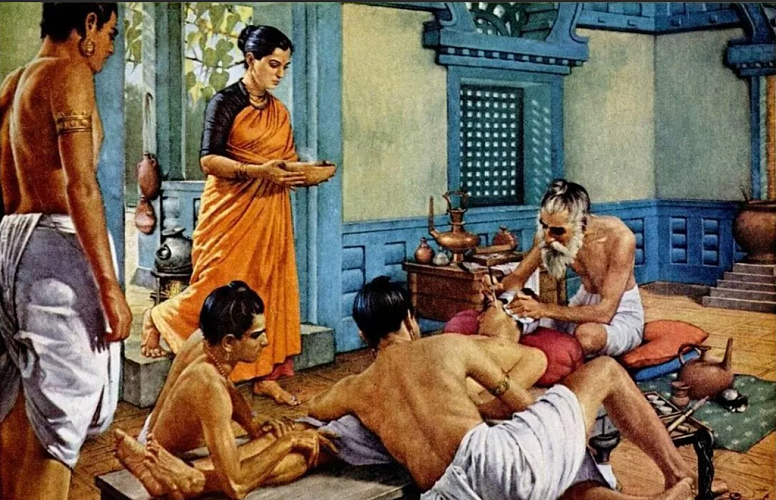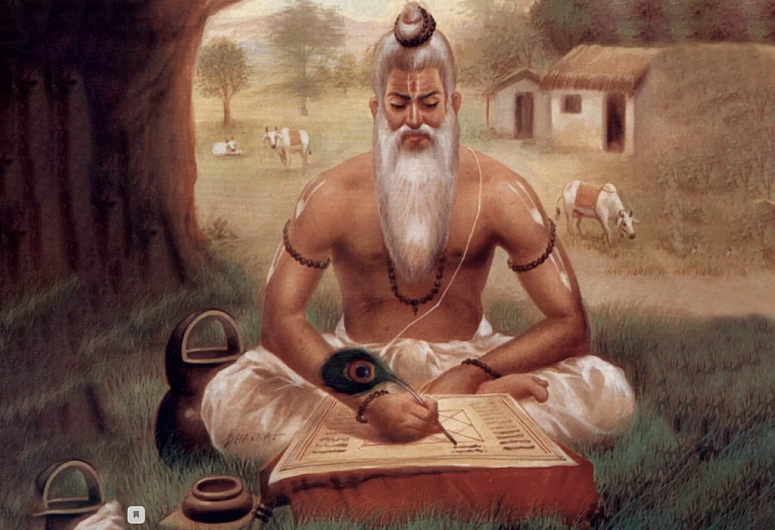Nowadays, just as many centuries before, а specialist in healing must have a wide spectrum of knowledge. It is not enough for a doctor to be a good ophthalmologist or an ENT (Ear, Nose and Throat doctor); in the conditions of present-day reality, he or she has to be a good psychologist as well. The ability to listen to a patient is sometimes even more effective, than any other therapy. Doctors that work in remotes areas, sometimes have to pull multi-duty and act as a one-person hospital. Such situations are not anything new: in ancient India, a traveling doctor had to know how to provide any help, including surgical. Most importantly, he often had to act immediately, with precision, to save the patient's life. That is why, “Sushruta-samhita”, a book on urgent care, including surgical treatment methods, is one of the most important parts of “Brihat Trayi”, “The Great Triad” treatise considered the greatest trio of Ayurveda.
The origin of “Sushruta-samhita” tractate
Sushruta's personality, as well as his tractate, are shrouded by many myths and legends. Actually, Ayurveda is closely connected with Dhanwantari, one of Vishnu’s avatars. According to the legend, Sushruta was his disciple. Sushruta had not only accumulated and used the knowledge he received to help people, but he also passed it down to his followers. In order to ensure dissemination of knowledge without quality loss, a decision was made to take it to paper. For this purpose, the sadhu appealed to Vishnu and, upon receiving Bhagavan’s blessing, got to work.
However, do not assume that the tractate the sadhu created is just a summary of all known information. In this work, Sushruta pioneers an opinion that blood is no other than the forth dosha. The Sadhu is persistent in his claim that most diseases can be healed with the help of bloodletting. At the same time, a doctor had to remember, that such a procedure must be carried out in accordance with certain rules, not to harm the patient.
Through his work, Sushruta helped to shape the development of all modern medicine. He described anatomy, muscle structure, tendons and ligaments in great detail. It is known that sadhu was strict with and demanding of his students: he believed that only a person with a cool mind and skilled hands could be a physician. “The one who is collected, has good manners, who is not speaking badly of others, strong and attentive – only such doctor can help a patient", - so holds the 34th chapter of “Sushruta-Samhita”.
In order to hone their surgical skills to perfection, sadhu’s students sharpened them first on fruit, and then on animal organs. Sushruta advocated for the necessity of corpse dissection, including those of humans, for study purposes, despite the fact that touching a dead body was forbidden in ancient India. However, the doctor was not scared of being considered “defiled”; he continued with this work without concern for himself. He wanted to apply the acquired skills for the benefit of all living beings, without regard for his own gains.
Unsurprisingly, such selfless person became recognized far beyond his motherland. Sushruta’s tractate was translated into several languages, including Latin, while his contribution to the medical field was acknowledged by historians and doctors from many countries of the world.
In his tractate, sadhu established the principles of disinfection in hospitals. He underlined the importance of incense fumigation in hospital rooms. Notably, the apamarga plant that he suggested for these purposes, does in fact cleanses the air off bacteria. Sushruta also provided painkiller recipes, described restorative and transplant surgeries for damaged organs (for example, an ear), which later formed the foundation of plastic surgery.
Here appears a question: which tractate is more important – “Sushruta-samhita” or “Charaka-samhita”? Both have tremendous value; they do not exclude, but, on the contrary, complement each other. If you can’t find an answer in “Charaka”, then it is definitely in “Sushruta”.
There is another, more prosaic, version regarding the origin of “Sushruta-samhita”, deprived of any mysticism or receiving of the knowledge from the Gods. According to this version, the tractate has several authors. There was a physician, who decided to consolidate the vast medical healing experience, regretting the fact that the weakening memory faculties of humans would not be able to preserve the knowledge and practice of medicine. It is this doctor who started to write down the medical knowledge accumulated over thousands of years. At a later time, another doctor, who was named after Sushruta, augmented the text by adding a doctrine on hospitals and personnel requirements to be followed by people wishing to work there. According to this version, this more contemporary Sushruta, initiated the discussion about the necessity of corpse dissection and autopsy, and it is he who became the “father” of modern-day surgery.
Which of the two versions to follow, is your decision. Despite the differences, these versions are unanimous in that the tractate was composed for the benefit and happiness of all people. And, essentially, it does not matter, who and under what circumstances did all this enormous work. In aggregate, it is a priceless contribution not only to Ayurveda and the field of surgery, but to the healthful, harmonious existence of hundreds of thousands people.
Main tenets of “Sushruta-samhita”
The language of“Sushruta-samhita” is simple and can be easily understood by modern people. The tractate includes 6 books, which are divided into 186 chapters. The first book is called “Sutra-sthana”and includes 46 chapters. It talks about the origin of Ayurveda and its essence. Partially these and other common principles can also be found in the “Charaka” tractate as well. This part of “Samhita”provides the description of three doshas and basic surgical instruments, and raises questions about the connection between seasons and the health of a human.
The next book, "Nidanana Samhita", is less in volume than the previous one; it includes only 16 chapters that talk about symptoms of diseases and different pathologies.
The third book, “Sharira sthana”, is divided into ten chapters. Anatomy and embryology are discussed in detail here.
The fourth book, “Chikitsa sthana”, has 40 chapters that tell about the treatment of various diseases.
Toxicology issues are discussed in “Kalpa Sthana”, which consists of 8 chapters.
The last, sixth book “Uttara sthana” has 66 chapters, devoted to the healing of diseases that hadn't been previously described. It also talks about methods of surgical intervention.
It is noteworthy that every chapter stars with the words: “Thus said the great Dhanvantari”. This repetition emphasizes the source of the text and respect for the one who gave people this knowledge about the science of healing. Throughout the whole tractate, Sushruta reminds us that human life is just a moment, a transitional state. Any illness is the reason to think, how and for what purpose a person lives. The physician is convinced, that the one who follows the righteous way and honors dharma, is immune to sickness. Constantly look within yourself and be mindful of your thoughts and actions - this is the main advice of the great Sushruta. He saw this as the principal preventative measure against any disease.
Sushruta сalls on us to try and see the Divine in everything, to not divide people into castes, as we are all parts of one whole. Sadhu himself was living example of this principle, accepting anyone as his student, even people from the shudra castе, for the Sadhu valued not the caste but the willingness and sincerity of the person.
The greatest doctor of the past insisted that constant practice is necessary. Any doctor possessing merely theoretical knowledge, he compared to a one-winged bird. History knows cases, when healers, who cured with herbs and ointments, turned patients down, but not an instance, when Sushruta would refuse a patient: he helped everyone.
Obstetrics, including the well-known caesarian, would be impossible without Sushruta’s knowledge. It is believed, that his instruments were so sharp, they could split a hair.
Even today, many years later, it is hard to overestimate the legacy of this legendary physician. These tractates are not just doctor's notes or a recipe book. It is deep work, putting a spotlight on ethical norms and moral guidelines, which must be upheld by both - the patient and the doctor himself. Such tractates must be studied by all doctors, irrespective of their specialization. This is truly a treasure trove of knowledge, kept with care and passed down to us, people of the new millennium who often forget to look for the reason of our own problems within ourselves. This is another opportunity to think, analyze our lifestyle, and start changing for the better in order to live a long, healthy and happy life.

